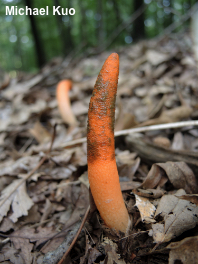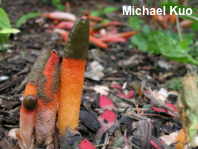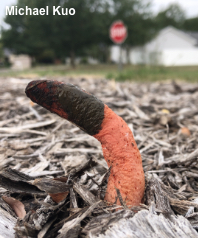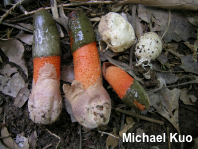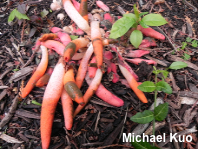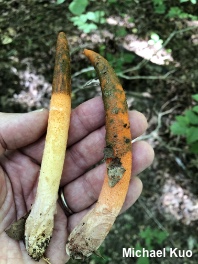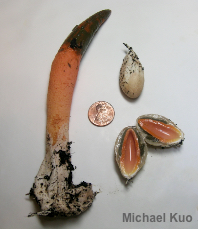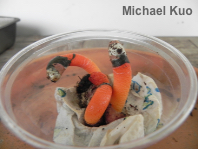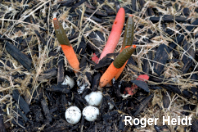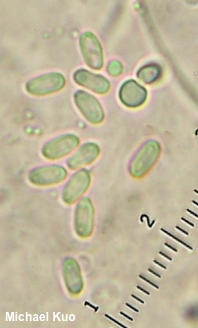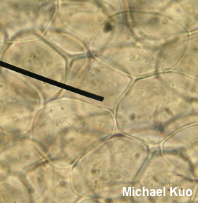| Major Groups > Stinkhorns > Mutinus elegans |

|
Mutinus elegans [ Basidiomycota > Phallales > Phallaceae > Mutinus . . . ] by Michael Kuo Stinkhorns are incredibly diverse in their features, but species of Mutinus are fairly unique in their appearance: they look like spikes that arise from whitish "eggs" in the ground, and they are initially covered with brown, stinky spore slime (before the slime is ravaged by flies). Unlike Phallus species, which have a separated head structure, Mutinus species consist of a simple, headless stem—although the bottom edge of the zone of spore slime is sometimes abrupt and clearly defined, creating the illusion of a head or cap. In short, if Phallus species mimic human anatomy, Mutinus species have more of a canine thrust. Among the North American species of Mutinus, Mutinus elegans can be recognized by the orange color of its fresh, unfaded stem. Other North American Mutinus taxa have red, pink, or white stems when fresh. Additional separating features include the lilac shades often found on the "eggs" and volva of Mutinus elegans, the fact that the zone of spore slime is often only vaguely defined at the bottom once the mushroom has begun to mature, and the "typical" gracefully tapered stature of the species. However, the last two features are inconsistent; frequent specimens have clearly demarcated slime zones at maturity, and stubby to nearly cylindric fruiting bodies are not uncommon. Be sure to assess the color of the stem with fresh, unfaded specimens, since older specimens can fade to whitish and pinkish (enlarge the second and fifth illustrations to the right), appearing more like Mutinus ravenelii—or, sometimes, post-mature stems darken to red, recalling Mutinus bambusinus. Phallus rugulosus is similar in appearance to Mutinus elegans, but has a structurally distinct head that hangs skirt-like from the tip of the stem. Mutinus caninus is also similar; it is found primarily in Europe, but does appear in North America—at least in Ohio. Its zone of spore slime is much smaller, and more clearly demarcated. Mutinus curtisii is a synonym. Thanks to Emily Gianfortoni and Roger Heidt for documenting, collecting, and preserving Mutinus elegans for study; their collections are deposited in The Herbarium of Michael Kuo. Thanks to Stephen Canfield for help with translation of the protologue (Montagne 1856). Description: Ecology: Saprobic; growing alone or gregariously in gardens and cultivated areas, or in woods; summer and fall; originally described as "indigenous to North America" (Montagne 1856); widely distributed in eastern North America and the Midwest, from the northeastern United States to Ontario, Minnesota, Texas, and Florida; also present in Hawaii and in temperate Europe. The illustrated and described collections are from Illinois, Iowa, Oklahoma, and Virginia. Immature Fruiting Body: A whitish to purplish "egg" 2–3.5 cm high and 1.5–2 cm wide; surface smooth; when sliced revealing the stinkhorn-to-be encased in a gelatinous substance. Mature Fruiting Body: 6–18 cm high; 1–2 cm thick at widest point; cylindric, usually with a gradually tapered apex, but occasionally with the apex more abruptly tapered; hollow; spongy, granular and wrinkled when young, becoming finely pocked; bright orange to yellow-orange when fresh; fading to pale orange, yellow, pinkish, or nearly white—or, occasionally, darkening to red; apex sometimes becoming perforated at maturity; when fresh covered with brown to olive brown spore slime in an apical zone for one-fourth to one-half the length of the stinkhorn; apical portion, under the spore slime, usually darker, reddish orange; base encased in a whitish to purplish, sacklike volva; attached to thin white rhizomorphs. Odor: Foul and strong while the spore slime is present. Microscopic Features: Spores 3.5–5 x 1.5–2 µm; cylindric or subcylindric; smooth; often with two tiny polar droplets; hyaline in KOH. Sphaerocysts of the pseudostipe 15–60 µm across; irregularly subglobose; walls 0.5–1 µm thick; smooth; hyaline in KOH. Hyphae of the volva 2–7 µm wide; smooth; septate; hyaline in KOH. Clamp connections not found. REFERENCES: (J. P. F. C. Montagne, 1856) E. Fischer, 1888. (Lloyd, 1908; Coker & Couch, 1928; Smith, 1951; Smith, Smith & Weber, 1981; Phillips, 1991/2005; Lincoff, 1992; Metzler & Metzler, 1992; Horn, Kay & Abel, 1993; Hemmes & Desjardin, 2002; Roody, 2003; Miller & Miller, 2006; Kuo & Methven, 2010; Kuo & Methven, 2014; Trierveiler-Pereira et al., 2014; da Silva et al., 2015; Woehrel & Light, 2017; Elliott & Stephenson, 2018; McKnight et al., 2021; Melanda et al., 2021.) Herb. Kuo 05030603, 05170701, 06121101, 06071401, 06081701, 06021801, 09191802, 10071801. Herb. CSU CLO 3674, CLO 3954. This site contains no information about the edibility or toxicity of mushrooms. |
|
|
Cite this page as: Kuo, M. (2021, August). Mutinus elegans. Retrieved from the MushroomExpert.Com Web site: http://www.mushroomexpert.com/mutinus_elegans.html © MushroomExpert.Com |
